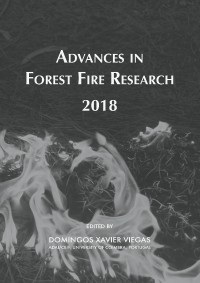Please use this identifier to cite or link to this item:
https://hdl.handle.net/10316.2/44618| Title: | Atmospheric flow and a large fire interaction: the unusual case of Pedrogão Grande, Portugal (17 June 2017) | Authors: | Pinto, Paulo Silva, Álvaro |
Keywords: | mesoscale convective system;outflows;shear lines;fire blowup;downburst;weather radar | Issue Date: | 2018 | Publisher: | Imprensa da Universidade de Coimbra | Journal: | http://hdl.handle.net/10316.2/44517 | Abstract: | On the afternoon of 17th June 2017 the fire was progressing in a hilly region of central mainland Portugal. A hot and dry atmosphere, characterized by a classic inverted V profile, typical from dry downburst environments (Weisman and Klemp, 1986), was in place, thus favoring high level based convection. In fact, an MCS that was observed both on satellite imagery and weather radar, has developed southeast of the fire area and, during the afternoon of this day, produced several downbursts that were recorded in several automatic weather stations (AWS). It was found that several shear lines, identified on Doppler radar, were considered to be consistent with convective outflow gust front surges that emanated from a downburst, or downbursts, generated by the MCS, and propagated over the fire area. It was verified that as this happened, the fire suffered an outstanding intensification, having produced a very violent and widespread firestorm that materialized an Extreme Fire Behavior (EFB), confirmed by ground survey (Viegas et al, 2017). As an outcome of this first interaction between the atmosphere and the fire, it was observed that a vertically developed dry pyroconvective column formed and made its way through the MCS anvil, placed overhead the fire by that time. Soon after, this smoke column top altitude decreased more than 5000 m in just 10 minutes. This remarkable behavior, resembling a downburst top collapse, was accompanied by a rapid low level plume displacement, interpreted as a result of the downburst induced circulation close to the ground. Just 10 minutes later, another fire blowup occurred, as the plume started to grow vertically. This second outstanding pyroconvective column growth was seen as a direct result of the stated downburst induced circulation at low levels that, as it was manifesting, induced another EFB episode. | URI: | https://hdl.handle.net/10316.2/44618 | ISBN: | 978-989-26-16-506 (PDF) | DOI: | 10.14195/978-989-26-16-506_101 | Rights: | open access |
| Appears in Collections: | Advances in forest fire research 2018 |
Files in This Item:
| File | Description | Size | Format | |
|---|---|---|---|---|
| atmospheric_flow_and_a_large_fire_interaction.pdf | 1.74 MB | Adobe PDF |  |
Items in DSpace are protected by copyright, with all rights reserved, unless otherwise indicated.
